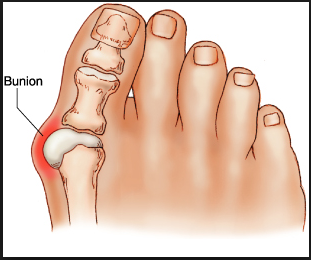
Over time, the base of the big toe pushes outward against the first metatarsal bone, which is directly behind it. The result is a bunion -- a bony, often painful hump at the base of the big toe. Bunions form at a joint. ... And, because your shoe likely rubs against it, a bunion can also cause calluses to form.
Bunions form when the bone or tissue at the joint at the bottom of the big toe moves out of place. Years of abnormal motion and pressure on the joint forces the big toe to bend toward the others, which causes an often-painful lump on the joint.
This joint at the base of the big toe carries much of your weight while walking, so bunions can cause severe and constant pain. The joint may become so stiff and sore that shoes may be too painful to wear.
Are stilettos to blame?
Bunions often run in families, but they also can be the result of the way we walk or the shoes we wear, says podiatrist Georgeanne Botek, DPM, Head of the Section of Podiatry and Medical Director of Cleveland Diabetic Foot Clinic.
People with flexible joints seem to tolerate their bunions more, Dr. Botek says. But others with stiff joints or arthritis usually have more trouble with their bunions and might develop pain earlier, she says.
Treatment without surgery
All bunions are permanent unless surgically corrected. But there are some measures you can take to be more comfortable or to slow the progression of bunion
“For many people, it may simply be a matter of wearing properly fitting shoes,” Dr. Stock says. “Be sure to choose low-heeled, comfortable shoes that provide plenty of space for your toes and the widest part of your foot.”
Dr. Stock says these seven approaches may relieve the pain and pressure on the toe joint:
- Maintain a normal weight.
- Protect the bunion with a moleskin or gel-filled pad, which you can buy at a drugstore.
- Use shoe inserts to help position the foot correctly. These can be over-the-counter arch supports or prescription orthotic devices.
- Under a doctor’s guidance, wear a splint at night to hold the toe straight and ease discomfort.
- Take non-steroidal anti-inflammatory drugs such as ibuprofen.
- Use warm soaks, ice packs, Whirlpool, ultrasound and massage.
- Buy well-fitting footwear that are wide in the toe area. Shop at a store where the staff measures your foot and can fit you with an appropriate shoe.
Some patients are interested in treating their bunions by stretching the feet to realign the toes, or using devices such as toe spacers or bunion splints, Dr. Botek says. Often though, the device is like a pair of eyeglasses – when you take it off, the benefit is gone.
“It would not completely realign your toe permanently,” Dr. Botek says.
Mawuena Workartey/ Ghanahospitals.org